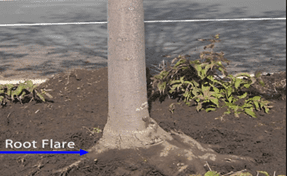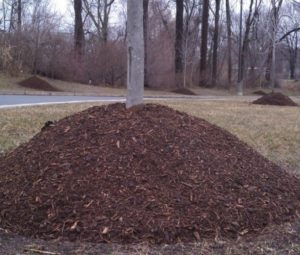 By Chuck Whealton, Director of Landscape Management Systems
By Chuck Whealton, Director of Landscape Management Systems
Hardwood mulch as a product, and mulching as a horticultural practice, has greatly evolved over the last fifty years, and not necessarily to the benefit of plants. The perceived value and purpose of mulching today is largely for the aesthetics. There has been a complete shift in the raw material, from bark to largely composted green waste and processed wood mulch, which is mostly cellulose and has a slower rate of decomposition. In addition, commercial contracts routinely call for one or more annual applications of two inches or more of fresh mulch, without regard to the amount of mulch already present. All of this has resulted in an epidemic of over-mulched landscapes that pose a serious health risk to plants.
This is why, as contradictory as it sounds, de-mulching is a very necessary service we offer our customers.
 What is de-mulching?
What is de-mulching?
De-mulching is the process of exposing the tree’s root flare by removing excess mulch, decomposed mulch and soil off of the tree saucer down to the root flare, which is the area at the base of the tree where the trunk transitions from trunk and bark tissues into root system tissues.
Why is this an important and necessary process?
In short, over-mulch suffocates the plant. People hear that but are not really sure what it means, so I’ll share a bit of plant biology to clarify. Root flare burial inhibits gas exchange and kills phloem cells, interfering with the downward movement of food to the root system, leading to root dieback, reduced water uptake and eventually the early death of the tree. A tree’s vascular system is comprised of two types of tissue that transport food/energy, nutrients, and water: the xylem transports nutrients and water from roots to shoots, while the phloem transports food sugars from the shoots to the roots. In human terms, think of the xylem and phloem as the plant’s veins and arteries.
 What are the visual signs of buried root flares and over-mulching of trees?
What are the visual signs of buried root flares and over-mulching of trees?
The obvious sign is not being able to visually locate the root flare. The first evidence that a buried root flare is negatively impacting tree health is a yellowing of the foliage and early leaf coloration and drop. Over time, symptoms include stunted leaf size, reduced rate of growth, and dieback in the upper crown. This weakened state predisposes the tree to disease and a variety of other environmental factors.
Shallow-rooted trees such as maples, dogwoods, birch, ash, pin oak, spruce and eastern white pine are most susceptible to damage from root flare burial.
What are the causes of root flare burial and things to avoid?
- Not tapering mulch to leave root flare exposed
- Applying mulch strictly for aesthetic purposes, in some cases multiple times per year
- Failure to cultivate and remove at least some amount of existing mulch. Trees should never have more than a total of three to four inches of mulch (old and new).
- Throwing edging debris into the tree saucer and covering it with extra mulch
- Not removing the soil saucer after establishment on a newly planted tree and instead, filling it in with soil or mulch.
What should we keep in mind for a successful de-mulching?
- De-mulching should be performed for all trees that have a buried root flare. Trees in beds are not exempt from this process.
- This process is likely to be needed as a function of routine maintenance every five to seven years on average, assuming fresh mulching annually for aesthetics is a customer expectation and requirement.
- Original planting soil rings should be removed two to three years after initial planting.
- If addressed in time, declining trees will recover. Based on the severity of decline, trees may need monitoring and supplemental care.
- Mulching new plantings with hardwood mulch to aid initial establishment has been well documented as an accepted and specified horticultural practice, however, mulching existing landscapes more frequently, purely for the aesthetic value has presented new horticultural challenges.
You may be pleasantly surprised at the long-term benefits that this seemingly simple procedure can have on the overall health of your landscape. If you think your property is in need of a de-mulching treatment, contact your area manager to schedule an assessment.

